How to download an app, file, or program from the Internet

This page contains information on downloading many types of files from the Internet, including audio clips, documents, PDF files, programs, and pictures. Instructions for downloading files are available for all modern browsers on computers, smartphones, tablets, and Chromebooks. Select a link below to learn more about downloads and downloading files.
What is a download?
To download is to receive data from the Internet to be stored and opened. Downloading should not be confused with copying or saving, which handles files not on the Internet (e.g., copying files to another location or saving a document). Also, a download is not an upload, which is sending a file from one computer to another.
Files on the Internet may contain viruses or malware. Protect your computer by installing an antivirus and anti-malware program and keeping it up-to-date; see: How to update an antivirus program.
How to download on a computer using different browsers
- To initiate a download from a website, you must first click a download link. A link is usually denoted by different-colored text with an underline, but it may also be an icon or button. To download an audio file, picture, or other media that does not have a link, skip to our download examples for further help.
- After clicking a file link, the browser starts the download or asks what to do, depending on the browser you're using. Below is additional information on how each modern browser handles downloads.

Google Chrome
After the download is completed, a prompt appears in the upper-right corner of the browser window. Click the downloaded file to open it.


Mozilla Firefox
- After the download has completed, a prompt appears in the center of the browser window. Click Save File and select where to save the file on your computer.
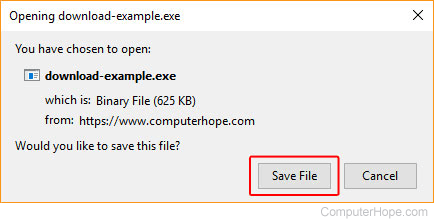
- After the file is saved, click the downloads progress
 icon in the upper-right corner of the browser window, and then the downloaded file to open it.
icon in the upper-right corner of the browser window, and then the downloaded file to open it.
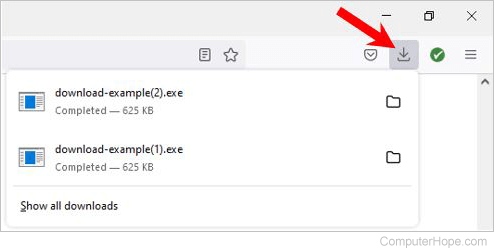
Alternatively, press Ctrl+J to open the Downloads section of the Library.
- In the Library window, double-click the downloaded file to open it.


Internet Explorer
- After the download is completed, a prompt appears at the bottom of the browser window in the middle. Choose Run or Save to open the downloaded media.

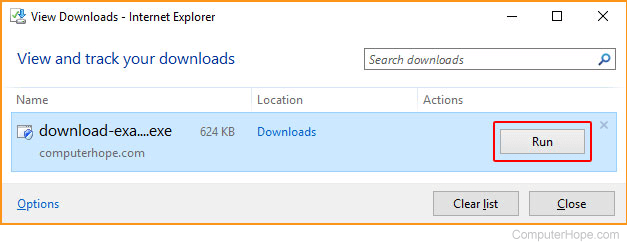
- Click Run to open any of the downloaded files.

Microsoft Edge
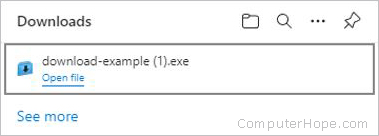
- Click the downloaded file to open it.

Opera
- After clicking a download link, you are prompted to choose where the file should be saved. Select a location and click Save.

- When the download completes, press Ctrl+J to view your recent downloads.
- In the window, locate your downloaded file and click the Run button to open it.


Safari
- Upon clicking a download link, you may be asked to allow downloads from the website. Click the Allow link.
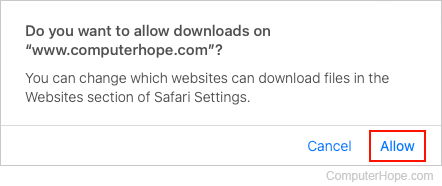
- After the download has completed, on the right side of the Dock, click the Downloads app shortcut and select Open in Finder.

- The window that opens shows all of your recent downloads in the section on the right.
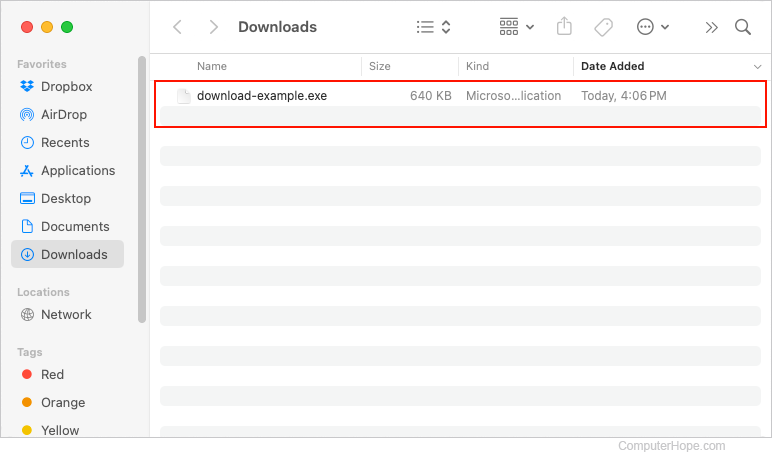
- You may double-click the downloaded file to open it.
How to download on a smartphone or tablet

You can download files from a web page on an Android smartphone or tablet or an Apple iPhone or iPad. Select your type of phone or tablet below and follow the instructions.
Android phone or tablet
- Open the Chrome browser.
- Navigate to a web page containing a file you want to download.
- Tap and hold your finger on the file's download link until a menu of options appears, then release your finger.
- Tap the Download link or Download image option in the menu.
- If necessary, tap the Download option again, which may be required for some files to complete the download.
- Open the Downloads or My Files app on your Android phone to view the downloaded files.
iPhone or iPad
- Open the Safari browser.
- Navigate to a web page containing a file you want to download.
- Tap and hold your finger on the file's download link until a menu of options appears, then release your finger.
- Tap the Download Linked File option in the menu.
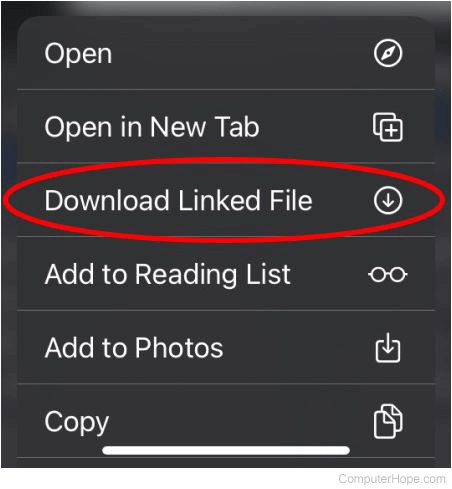
- If a small window appears asking to download the file, tap Download.
- To view the downloaded files, click the blue circle icon with a down-pointing arrow inside, located to the right of the address bar.
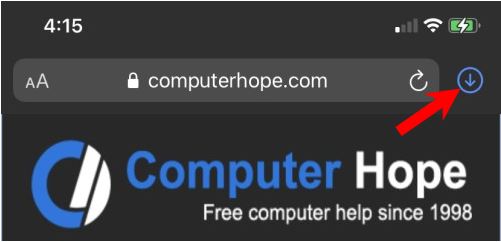
- A list of downloaded files is displayed. If compatible with the iPhone, you can tap a file name to view it or execute the file.
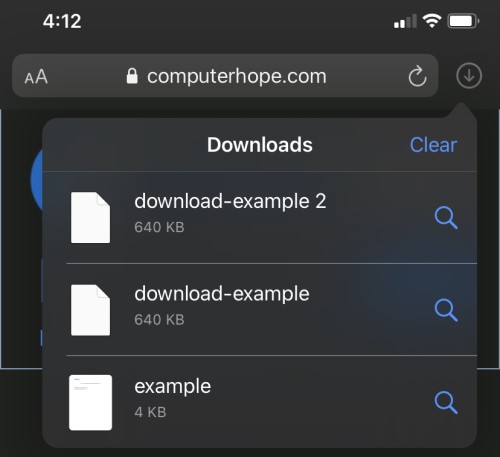
How to download on a Chromebook
Downloading a file on a Chromebook is similar to downloading on a computer, with slight differences.
- Open the Chrome browser.
- Navigate to a web page containing a file you want to download.
- Click the appropriate link to download the file to your Chromebook. A Download Manager pop-up window appears in the bottom-right corner when the file is downloaded.
- Click the Show In Folder link in the Download Manager pop-up window to view the downloaded files.
You can also press the keyboard shortcut Ctrl+J to view your downloaded files.
Examples of popular download types
Apps or programs
Popular download are apps or programs installed on your computer. For Windows computers, these files are often .exe files, and for Apple computers, they are either .dmg or .app files.
Many programs may also be included in a compressed file. If the download file or link ends with .arj, .zip, .tar, or .tgz, see the next section for downloading and extracting compressed files.
Below is an example executable file to run on your Windows computer. This executable file displays the message, "Congratulations, you've successfully downloaded an executable program file from the Computer Hope Website."
Hardware drivers
Today, most drivers are either included in a compressed file (see next section below) or are contained in a self-extracting executable file.
If you're having trouble figuring out how to install the drivers you have downloaded, look for a readme file with this information. For additional help, use the link below to install drivers on a computer.
Compressed files (e.g., .zip and .rar)
Compression techniques reduce file sizes or package several files together. Compressed files may end with a .7z, .arj, .rar, .tgz, or .zip file extension. After they've been downloaded, these files must be decompressed before running or being viewed.
Below is an example compressed file called example.zip. Once this file is downloaded, you'll need to decompress the file, which contains a readme.txt and a download-example.exe file.
Audio files (e.g., .mp3)
Downloading an audio file (e.g., an MP3) from a link is like downloading any other basic file from the Internet. Different downloading techniques must be used for web pages that utilize streaming audio or embedded audio, as explained on the page linked below.
Movie files
Downloading a movie file (e.g., an MP4) from a link is similar to all other file downloads. However, you can also right-click the link and choose Save link as, Save target as, or the Save linked content as option. If an embedded movie has an arrow pointing down next to the audio controls, use that link to download the movie. Other streaming movie services that do not have a download link may require additional software to capture the video. The link below has further instructions.
Below is an example link to an MP4 video file. To download it, right-click the file and select Save link as, Save target as, or Save linked content as.
YouTube videos
Steps on downloading a YouTube video or its audio are on the pages linked below.
Pictures or images

Any picture or image on the Internet can be saved to your computer (downloaded). For example, the following steps walk you through downloading the Computer Hope logo seen to the right.
- Right-click the image.
- From the drop-down menu, select Save image as or Save Picture as.
- Choose the location on the computer or other drive, such as a USB drive, where you want to save the image.
Once an image is saved, you may open it with an image editor or another program that supports the image's file format.
You can also copy the image and then paste it into any document or graphics program.
PDF files
A PDF (Portable Document Format) file can be downloaded like most programs. Upon selecting a download link to a PDF file, most browsers open the PDF contents in the browser window rather than downloading the file. Below are the steps to download a PDF to your computer instead of only viewing it.
- Right-click any link that opens a PDF.
- Click the Save link as, Save target as, or the Save linked content as option.
- Choose where you want to save the PDF file.
You can follow the steps above with the link below to download our PDF example.
Word processor documents
Any link pointing to a document, such as those found in Microsoft Word, can download it. Click the following link to download example.doc to your computer to see the process in action.
If the browser is opening the document or the link isn't working, you can also right-click the image and choose Save link as, Save target as, or Save linked content as.
Spreadsheet or CSV files
A spreadsheet can be downloaded by clicking any link pointing to the spreadsheet file (.xls, xlsx). Click the link below to download the example.xls file created in Microsoft Excel to your computer to see the process in action.
If the browser is opening the spreadsheet or the link isn't working, you can also right-click the link and choose Save link as, Save target as, or Save linked content as.
Many websites that grab information from a database do not save the data as a .xls, .xlsx, or another spreadsheet file format. Instead, the files are saved as a CSV (comma-separated values) file. These files can also be downloaded in the same way and then imported into a spreadsheet program, like Microsoft Excel or Google Sheets.
Text files
By default, any link that points to a text file is opened in the browser. To save a text file to your computer to edit in a text editor, right-click the link and choose Save link as, Save target as, or Save linked content as. You can try this now by right-clicking the link below to download a readme.txt file.
